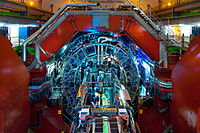
Photo from wikipedia
In recent years the understanding of the limits of the smallest possible droplet of the quark gluon plasma has been called into question. Experimental results from both the Large Hadron… Click to show full abstract
In recent years the understanding of the limits of the smallest possible droplet of the quark gluon plasma has been called into question. Experimental results from both the Large Hadron Collider and the Relativistic Heavy Ion Collider have provided hints that the quark gluon plasma may be produced in systems as small as that formed in pPb or dAu collisions. Yet alternative explanations still exist from correlations arising from quarks and gluons in a color glass condensate picture. In order to resolve these two scenarios, a system-size scan has been proposed at the Large Hadron Collider for collisions of ArAr and OO. Here we make predictions for a possible future run of ArAr and OO collisions at the Large Hadron Collider and study the system-size dependence of a variety of flow observables. We find that linear response (from the initial conditions to the final flow harmonics) becomes more dominant in smaller systems, whereas the linear+cubic response can accurately predict multiparticle cumulants for a wide range of centralities in large systems.
Journal Title: Physical Review C
Year Published: 2019
Link to full text (if available)
Share on Social Media: Sign Up to like & get
recommendations!